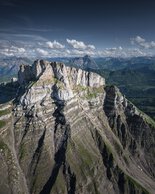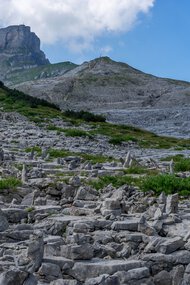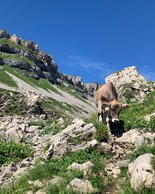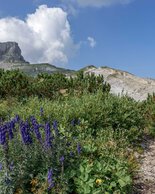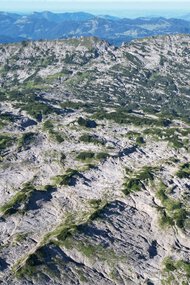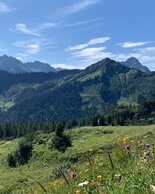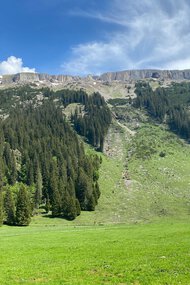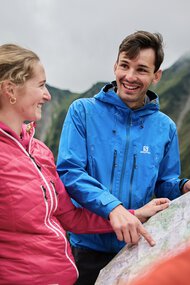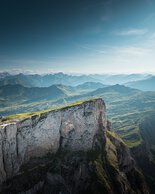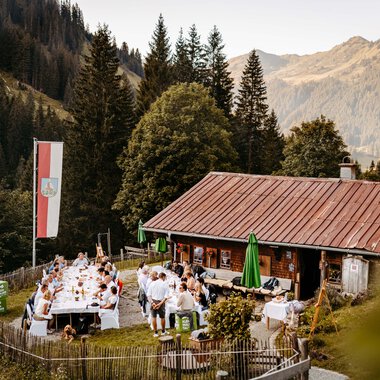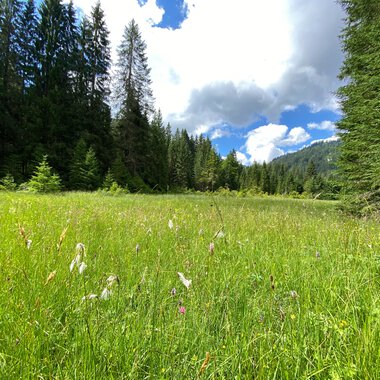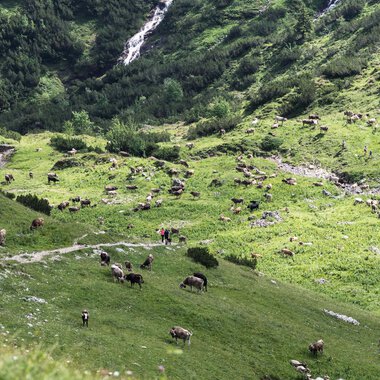Pearls of the Kleinwalsertal - The Ifen-Gottesacker European nature reserve
23.06.2021
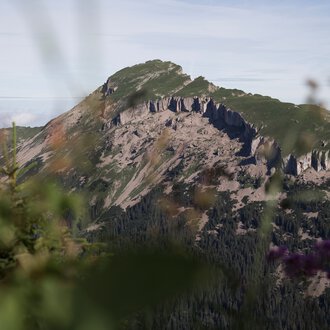
extraordinary summit
At 2,230 meters and with its striking plateau, the Hohe Ifen towers over the Kleinwalsertal. It is not only impressive to look at - its unique vegetation and geology make the Ifen and the adjacent Gottesacker plateau a European nature reserve (Natura 2000 area). The 4,916-hectare nature reserve straddles the German and Austrian borders in roughly equal measure. Due to its pristine nature and special vegetation, the Ifen-Gottesacker area is one of the most important karst landscapes in Vorarlberg.
The mysterious karst landscape
Are you wondering what a karst landscape is? In short, it is carbonate rock weathered by water. Yes, that sounds a bit complicated... let's try to describe it figuratively: The weathering (karstification) of the Schrattenkalk surface of the Gottesacker plateau creates cracks and fissures in the rock. If water penetrates the limestone through these cracks, it also dissolves the limestone inside and underground caves and tunnel systems can form. Quite simple really, isn't it?
These cave systems not only swallow up entire streams, such as the Schwarzwasserbach, which flows partly underground to Riezlern, they are also the habitat of endangered animal species. Especially in winter, they provide shelter for bats and birds.
the Gottesacker
North of the Ifen summit, the 10 km² Gottesacker plateau offers a bizarre but magnificent picture. At first glance, you see little - a barren area characterized by a cracked rock surface. On closer inspection, however, you realize that moisture and blown-in seeds collect in the cracks and carts, from which a unique alpine flora develops. Plants such as the rare Hungarian gentian, bright red alpine roses or the Swiss man's shield stand out colorfully against the grey limestone rocks. If you would like to take a closer look and find out more about the special features of the plateau, join the guided tour of the Gottesackerplateu.
the green Schwarzwassertal valley
On the other side of the Ifen summit, in the direction of the Schwarzwassertal valley, you will find further protected assets of the Natura 2000 area. The landscape is characterized by alpine calcareous grasslands, litter meadows (so-called “Urwiesen”) and montane spruce forests. Due to the rapidly draining water that collects at lower altitudes, moors are also not uncommon in the Ifen-Gottesacker area. The different habitats provide a breeding ground for a variety of rare plants and animals. Various species of woodpeckers and owls, majestic golden eagles, reptiles as well as smaller inhabitants such as the golden snail butterfly or the adder can be found around the Ifen. So it's worth keeping your eyes open!
Smart in the Natur
We now know that the list of remarkable flora and fauna in the Ifen Gottesacker European nature reserve is long. In keeping with the motto “Experience nature consciously”, I would like to give you a few tips for your next hike in the Ifen area - so that the list remains as extensive as it is now.
- Please leave plants and plant parts where they belong - in nature!
- Binoculars are the best way to observe undisturbed flora and fauna in nature
- Keep quiet so as not to disturb birds and other animals
- Keep dogs on a lead
- Take waste of any kind with you and dispose of it at your accommodation
- Stay on paths and marked trails
- No drone photography
- Bivouacking and camping is not permitted anywhere in the European nature reserve
our tour tips
Do you now want to see this natural spectacle for yourself? Experienced hikers can explore the area on two tours - via the Gottesacker plateau or to the Ifen with a descent via the Schwarzwasserhütte. The nature trail to the Ifenhütte is also suitable for leisurely walks and offers a magnificent view of the entire area. Don't forget to include a snack at the Ifenhütte.
Note: From an altitude of around 1,900 meters (also applies to Gottesackerplateau and Ifen), snow fields are to be expected depending on the season. Please note that markings, signposts and safety devices may not be visible or present.

